1. Introduction
Cultivation of sunflower (Helianthus annuus L.) as cut flower has increased in the last years due to characteristics such as short cycle, ease of propagation, adaptability to different edaphoclimatic conditions, rusticity, resistance to drought and, particularly, because its inflorescence is attractive and widely used in ornamentation [1,2]. Among the tropical flowers, the ornamental sunflower cultivar Anão de Jardim stands out for having varied stem heights and beautiful inflorescences, with diverse colors which range from light yellow to brown [3].
Ornamental sunflower production arouses interest of producers and investors due to its high profitability, for requiring small areas for its cultivation, intensive production and for providing fast economic returns. However, in order to achieve the desired yield, it is necessary to have water in sufficient amount to ensure the production, and this is a great challenge for producers, especially those in the Brazilian semiarid region, where the scarcity of water resources limits agricultural production.
The use of wastewater in agriculture has emerged as an alternative to make the production viable, especially in arid and semi-arid regions. However, the use of these waters in irrigated areas can cause damage to the soil due to the presence of salts [4], which can be prevented with the use of cultivation techniques such as hydroponics, as it allows the cultivation of plants in nutrient solution without soil.
Due to the high water use efficiency, hydroponic cultivation has been studied and utilized in arid and semi-arid regions for the production of several species, among others ornamental sunflower [1,5,2].
Hydroponic cultivation consists in intensive production of plant species, requiring low volumes of water, besides leading to earlier production and products of better quality, which allows for fast economic returns [6]. Cultivation in hydroponic system depends, among other factors, on the height of the species to be grown and especially on the availability and cost of materials to be used as inputs [7].
Hydroponic production systems have recently undergone several modifications aimed at adapting them to the environmental and socioeconomic conditions of the different regions [7]. Conventional structures with support trestles for the bench-type hydroponic profiles used [4] or alternative low-cost prototypes that need little space, for example the Pyramid-shaped structures used [1,8,2], represent potential structures for hydroponic cultivation.
In view of the imminent scarcity of good-quality water for agricultural purposes and the high cost of fertilizers used in hydroponic cultivation, the present study aimed to assess the use of treated domestic effluent as a source of water and nutrients for the production of ornamental sunflower cv. Anão de Jardim in a bench-type hydroponic system, inferring on its technical feasibility and study the possible impacts on the crop.
2. Material and methods
The experiment was conducted in a greenhouse in the experimental area of the Water and Soil Engineering Center of the Federal University of Recôncavo of Bahia, located in the municipality of Cruz das Almas, Bahia, Brazil, at geographic coordinates of 12º40’19” latitude South, 39º6’23” longitude West and mean altitude of 220 m. According to D’Angiolella et al. (2000), the climate of the region is classified as humid to sub-humid and, according to the Köppen’s classification, as Aw to Am, with annual mean rainfall, temperature and relative humidity of 1,224 mm, 24.5 °C and 80%, respectively [9].
The greenhouse, a twin-arch structure, installed in East-West direction is 14 m wide by 32 m long, with ceiling height of 4 m, maximum height of 5.5 m, and is protected by white shading net (‘Clarite’) on the sides, plastic film (anti-UV, 150 microns) on top and thermal-reflective net (Aluminet 50%) installed internally at ceiling height. The experiment was conducted in a completely randomized design, with four treatments (T1 - Nutrient solution (NS) of Furlani (1998) [6] 100%, prepared in municipal supply water - control), T2, T3 and T4 - NS of Furlani, 100, 75 and 50%, respectively prepared in treated domestic effluent) and six replicates, totaling 24 experimental plots. Each experimental plot was composed of 15 plants distributed in a hydroponic profile (PVC tube) in a bench-type structure similar to that reported by Silva et al. (2016) [4].
Twelve benches were built, each one with capacity to support two hydroponic profiles, consisting of 6.0-m-long PVC tubes (PN 40) with 75 mm diameter, spaced at 0.90 m with cells (planting orifices of 0.05 m) spaced at 0.30 m. Each hydroponic profile was connected to a plastic tank with capacity for 50 L, a circulating electric pump and a nutrient solution injection system. The profiles were installed horizontally (in leveled position with 0 slope) and their ends were closed with PVC caps perforated appropriately to induce the formation of a constant 25-mm-deep layer of nutrient solution.
An independent water supply system was installed in each hydroponic profile, which permitted the replenishment of the water consumed by plants. The supply system consisted of a cylindrical reservoir with nominal diameter of 150 mm, a graduated ruler and a transparent tube (5 mm diameter) vertically fixed to allow the reading of water level inside and a float valve which allowed water to flow and maintain constant level of the nutrient solution in the tank (Fig. 1).
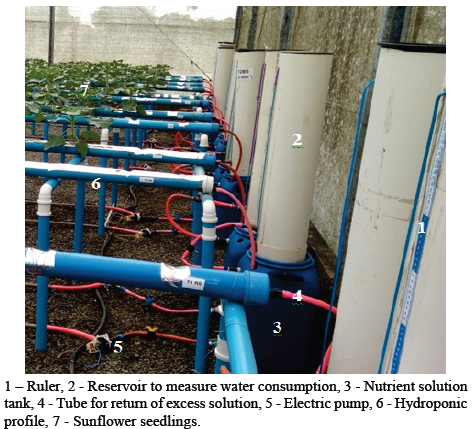
Source: The Authors.
Figure 1 Nutrient solution supply and circulation system connected to the bench-type hydroponic profile.
The treated domestic effluent used in the study came from the domestic sewage treatment unit of the Water and Sanitation Company of Bahia (EMBASA), located in the municipality of Muritiba - BA. At the treatment station, the domestic sewage first passes through a bar screen and grit chamber and a sandbox, which retains all solid material, and then goes to an anaerobic reactor and a facultative pond, where 90% of organic matter is digested and most of the pathogenic agents, such as viruses and bacteria, are eliminated. To avoid large variations resulting from seasonality, a sufficient volume was collected and stored to conduct the experiment. The collection, storage and physical and chemical analysis of the effluent and supply water (Table 1) were carried out as per recommendations of the United States Environmental Protection Agency [10].
Table 1 Characteristics of the treated domestic effluent (TDE) and supply water used in the experiment.
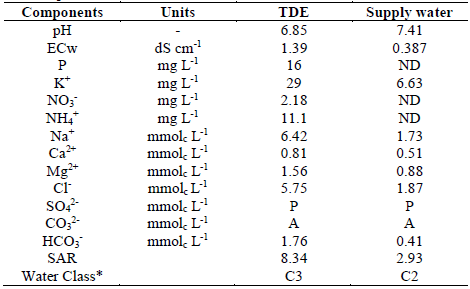
ND - Not determined, A - Absent, P - Present, SAR - Sodium adsorption ratio. *According to Richards [18].
Source: The Authors
The NS used was prepared in accordance with the recommendations of Furlani (1998) [6] using either municipal supply water or treated domestic effluent according to treatment. After preparation, the electrical conductivity of the nutrient solutions of treatments T1, T2, T3 and T4 was respectively 2.11, 3.53, 3.17 and 2.19 dS m-1. The frequency of NS recirculation in the hydroponic system had interval of 15 minutes (15 minutes on and 15 minutes off) during the day (between 06:00 and 18:00 h), with three events of the same duration during the night (at 21:00, 24:00 and 03:00 h).
Nutrient solution circulation was controlled by a digital timer. The electrical conductivity and pH of the NS were monitored every day. During the experimental period, the solution was not completely renewed, and standard NS (100% concentration) was added always whenever the EC in the control treatment (T1) decreased by 0.5 dS m-1. In order to maintain the electrical conductivity of the solution as close as possible to the original values, replenishment with the respective water (supply water - T1 or treated domestic effluent - T2, T3 and T4) was done daily at prefixed hours which also permitted estimation of nutrient solution consumed by the plants.
Plant height (PH), stem diameter (SD) and number of leaves (NL) were evaluated every 10 days after transplanting (DAT), whereas leaf area (LA), leaf (LDM) and stem dry matter (StDM) were evaluated every 15 DAT. In the last evaluation (at harvest), fresh (CAPFM) and dry matter of capitulum (CAPDM), internal (ID) and external diameter (ED) of capitulum were also evaluated. The content of N, P, K, Ca and Mg in leaf and stem tissues were determined according to the methodologies recommended by Tedesco et al. (1995) [11]. In addition, absolute (AGRShDM) and relative (RGRShDM) growth rates of shoot dry matter - ShDM (LDM + StDM) were estimated, using Equations 1 and 2, according to the methodologies recommended by Benincasa (2003) [12].
where:
AGRShDM - absolute growth rate of shoot dry matter (ShDM) in g day-1,
W1 and W2 - ShDM of plants at times T1 and T2 (day), respectively.
where:
RGRShDM - relative growth rate of shoot dry matter (ShDM) in g g-1 day-1,
ln - natural logarithm,
Wl and W2 - ShDM of plants at times T1 and T2 (day), respectively.
After verification of homoscedasticity and normality, the data were submitted to analysis of variance by F test and treatment means were compared by Tukey test at 0.05 probability level. Statistical analysis was conducted using the program SISVAR version 5.6 [13].
3. Results and discussion
There was no significant (p>0.05) effect of the treatments on the plant height (PH) of the ornamental sunflower in any evaluation period (Table 2) with overall mean height of 65.5 cm at 40 DAT. The mean value observed for plant height in this study is higher than that reported by [17] (40 to 50 cm) and that obtained by Souza et al. (2018) [2] - 54.8 cm, in a Pyramid-type hydroponic system using nutrient solution recommended by Furlani (1998). Differences observed may be due to readily available water and nutrients to plants and more space for growth in comparison to the study conducted by Souza et al. (2018), where vertical distance between hydroponic channels was limited to 40 cm [2].
Results obtained in the present study corroborate those reported by Oliveira et al. (2017), who observed no significant effect of the treatments on plant height in any period of evaluation in conventional cultivation (in pots) of ornamental sunflower, cv. Anão de Jardim, using different water depths and wastewater dilutions along with mineral fertilization [14].
The treatments had no significant effect (p>0.05) on stem diameter (SD) at 10 and 20 DAT. In these evaluations, plants grown in solution prepared in treated domestic effluent with 75 or 50% of nutrient concentration (T3 and T4) showed no alterations in SD compared to those in the control treatment, suggesting that these treatments provided adequate nutrition for the development of this cultivar until this period (Table 2). Souza et al. (2018) also did not observe significant differences between the SD means of the ornamental sunflower cv. Anão de Jardim cultivated in hydroponic structure of the Pyramid type using nutrient solutions prepared with different concentrations (100, 75 and 50%) in treated domestic effluent [2].
In the evaluations performed at 30 and 40 DAT, plants under the control treatment (T1) and those grown in NS with 100 or 75% of nutrient concentration prepared in treated domestic effluent (T2 and T3) did not differ significantly (p>0.05) and showed higher means compared to plants cultivated in NS with 50% of nutrient concentration (T4), which showed on average reductions of 15.07 and 15.40% in SD, at 30 and 40 DAT, respectively (Table 2). It is important to note that, despite the 50% reduction of nutrients in NS, the T4 plants showed mean SD of 15.02 mm (Table 2), an accepted value for commercialization of sunflower stems [15].
Table 2 Summary of F test and mean plant height (PH), stem diameter (SD), number of leaves (NL) and leaf area (LA) of ornamental sunflower cv. Anão de Jardim cultivated under different treatments at distinct periods of evaluation (days after transplanting - DAT).

* significant at 0.05 probability level, ns not significant at 0.05 probability level, T1 - Nutrient solution (NS) of Furlani [6] 100%, prepared in municipal supply water (control), T2, T3 and T4 - respectively, NS of Furlani, 100, 75 and 50% prepared in treated domestic effluent), C.V. - Coefficient of variation.
# Means followed by the same letter in the row do not differ by Tukey test at 0.05 probability level.
Source: The Authors
Such inferiority in the treatment T4 may be a consequence of the limitation of nutrients in relation to the plant requirements at this growth stage (stem elongation), especially in terms of K+, because according to Câmara (2003) sunflower has a high demand for this nutrient, and a significant part is stored in petiole and stem [3,16]. The results of plant tissue analysis (Table 5) revealed that the K+ content in the stem of the plants under T4 treatment was 15.62% lower than that of those in the control (T1), although the difference was not found to be statistically significant (p>0.05).
There was no significant effect (p>0.05) of the treatments on the number of leaves (NL) in any period of evaluation, and on average 33.3 leaves per plant was observed at 40 DAT (Table 3). Corroborating this result, Souza et al. (2018) also did not observe significant effect of treatments on the number of leaves of ornamental sunflower cv. Anão de Jardim cultivated in a hydroponic structure of the Pyramid type using nutrient solution prepared with different concentrations (100, 75 and 50%) in treated domestic effluent and, at the harvest after 45 DAT, the general average was 28 leaves [2]. In contrast, Oliveira et al. (2017) observed at 35 days after transplanting for the same cultivar irrigated with water containing 75% of wastewater showed on average two leaves more than the plants irrigated with supply water under organic fertilization. In the final evaluation, these authors observed no significant difference in the NL under different treatments, which had on average 30.05 leaves [14].
For leaf area (LA), there was no significant effect (p>0.05) in the evaluation performed at 15 DAT and the mean value was 0.095 m2. However, the treatments had significant effect (p<0.05) on LA at 30 DAT (Table 2). Plants in the treatment T1 (control) showed leaf area of 0.57 m2, significantly differing from those of the other treatments, which did not differ from one another and whose leaf area was on average 41.98% less than that of the control. Considering that there was no significant effect of the treatments on the number of leaves, the significant effect on LA must be a consequence of reduced leaf expansion (leaf size) in sunflower plants receiving nutrient solution prepared in treated domestic effluent (T2, T3 and T4).
For leaf (LDM) and stem dry matter (StDM), there was significant effect (p<0.05) of the treatments at 30 and 45 DAT (Table 3). The treatments had no significant effect (p>0.05) on LDM and StDM at 15 DAT, which may have been because plant growth in terms of PH, SD and NL until 20 DAT was similar in all treatments (Table 2), and the nutritional requirement of the plants at this stage was low. At 30 DAT, LDM did not differ between plants grown in the control treatment (T1) and those cultivated with NS 100% prepared in treated domestic effluent (T2). Plants in the control treatment showed a significantly higher (14.87%) mean compared to that of plants grown in NS with 75% of the concentration of nutrients prepared in treated domestic effluent (T3). Plants cultivated in NS with 50% of the concentration of nutrients prepared in treated domestic effluent (T4) showed the lowest mean (9.83 g plant-1), showing a reduction of 43.11% compared to the control treatment (T1). The reduction of LDM observed in plants of the treatment T4 is a consequence of their significantly lower growth (SD and LA) (Table 3).
Table 3 Summary of F test and means of leaf (LDM) and stem dry matter (StDM), absolute (AGRShDM) and relative growth rate in shoot dry matter (RGRShDM) of ornamental sunflower cv. Anão de Jardim cultivated under different treatments at distinct periods of evaluation (days after transplanting - DAT).
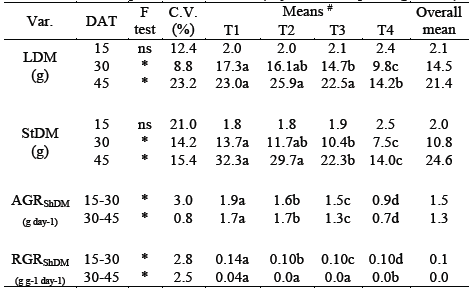
*significant at 0.05 probability level, ns not significant at 0.05 probability level, T1 - Nutrient solution (NS) of Furlani [6] 100%, prepared in municipal supply water (control), T2, T3 and T4 - respectively, NS of Furlani 100, 75 and 50%, prepared in treated domestic effluent), C.V. - coefficient of variation.
# Means followed by the same letter in the row do not differ by Tukey test at 0.05 probability level.
Source: The Authors
For StDM, in the evaluations performed at 30 and 45 DAT, there was no statistical difference between the control treatment (T1) and T2 - 100% of NS prepared in treated domestic effluent. The mean StDM decreased in plants under the treatments with 75 and 50% of the NS prepared in treated domestic effluent (T3 and T4) and the lowest values (7.52 and 14.02 g plant-1, at 30 and 45 DAT, respectively) were observed in plants of the treatment T4, significantly different in relation to all other treatments (Table 3).
Likewise, Souza et al. (2018) also observed a significant effect of treatments on leaf dry matter (LDM) and stem dry matter (SDM) at 30 and 45 DAT, verifying similar behavior for both variables [2].
Plants in the treatments with 100% NS prepared in supply water or treated domestic effluent (T1 and T2, respectively) showed higher ShDM accumulations and similar behavior, whereas those under the treatments with 75 and 50% NS prepared in treated domestic effluent (T3 and T4) showed reduction in accumulation of ShDM compared to the other treatments (Fig. 2). A linear and highly significant (R2>0.99) relationship was observed between ShDM and plant age, which permits estimation of accumulation of ShDM along the growth period (DAT). Considering that on average sunflower shoots contain about 90% moisture, the fresh matter yield after harvest may be on the order of 200 to 500 g plant-1 depending upon treatment, which can be used as fodder of excellent quality for the animals and may be an additional source of income for the farmers.
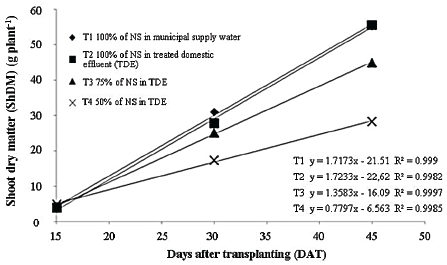
Source: The Authors
Figure 2 Shoot dry matter (ShDM) of ornamental sunflower cv. Anão de Jardim cultivated in different treatments at 15, 30 and 45 days after transplanting (DAT).
The absolute (AGRShDM) and relative (RGRShDM) growth rates in shoot dry matter were significantly affected (p<0.05) by treatments in both (15-30 and 30-45 DAT) intervals studied (Table 3). Ornamental sunflower plants during the 15-30 DAT period exhibited higher AGRShDM and RGRShDM, on average 1.47 g day-1 and 0.12 g g-1 day-1, respectively, compared to the period of 30-45 DAT (1.34 g day-1 and 0.04 g g-1 day-1), which may have been the result of the transition between the vegetative to the reproductive stage of the plant development. Table 3 also shows significant differences between the treatments, and the growth rates varied in the following sequence T1>T2>T3>T4. Plants under the treatment with 50% concentration of nutrients prepared in treated domestic effluent (T4) showed the lowest values of AGRShDM and RGRShDM, with substantial reduction (more than 50%) in AGRShDM in comparison to the treatments T1 and T2. These results were caused by the lesser dry matter accumulation in leaf and stem in this treatment, as previously explained and discussed.
The AGRShDM indicates the variation of growth within a certain time interval and gives an idea about the mean growth rate over the observation period. The RGRShDM expresses the increase of dry matter per unit of preexisting mass, within a time interval, giving an idea about the boost of growth. Thus, RGRShDM has been considered the most adequate measure to evaluate plant growth [12].
By evaluating the treatments based on RGRShDM and on the saving of fertilizers, it is possible to see that the data indicate that NS prepared with supply water and containing 100% of the concentration of nutrients (T1) can be used until 30 DAT, whereas the NS prepared with treated domestic effluent containing 75% of the concentration of nutrients (T3) is the most recommended for the rest of the crop cycle.
For fresh (CAPFM) and dry matter of capitulum (CAPDM), there were significant differences (p<0.05) between the control treatment (T1) and the others (T2, T3 and T4), which did not differ statistically (p>0.05) from one another. Plants submitted to treatments containing NS prepared in treated domestic effluent (T2, T3 and T4) showed on average reductions of 31.81 and 34.77% for CAPFM and CAPDM, respectively, compared to the control treatment (T1) (Table 4). Souza et al. (2018) also observed a reduction in capitulum dry matter (CAPDM) of ornamental sunflower cv. Anão de Jardim cultivated in nutrient solution prepared in treated domestic effluent compared to the control treatment, in which the solution was prepared with supply water [2].
Table 4 Summary of F test and mean capitulum fresh (CAPFM) and dry matter (CAPDM), internal (ID) and external diameter (ED) of ornamental sunflower cv. Anão de Jardim cultivated in different nutrient solutions at harvest.

*significant at 0.05 probability level, ns not significant at 0.05 probability level, T1 - Nutrient solution (NS) of Furlani [6] 100%, prepared in municipal supply water (control), T2, T3 and T4 - respectively, NS of Furlani, 100, 75 and 50%, prepared in treated domestic effluent), C.V. - coefficient of variation.
# Means followed by the same letter in the row do not differ by Tukey test at 0.05 probability level.
Source: The Authors
The external diameter (ED) of the capitulum of plants in the control treatment (T1) and in the treatment of NS with 50% of the concentration in treated domestic effluent (T4) were larger and did not differ (p>0.05) from each other, however, the ED of sunflower plants grown in T1 differed statistically (p<0.05) from those of plants cultivated in treatments with 100% and 75% NS prepared in treated domestic effluent (Table 4).
The results for ED of the ornamental sunflower cv. Anão de Jardim are similar to those found in the study conducted by Oliveira et al. (2017), who used different wastewater dilutions for the same sunflower cultivar and observed means ranging between 15.20 and 16.25 cm. According to indications of [17], the external diameter of the inflorescences of the cv. Anão de Jardim may vary from 14 to 18 cm.
Sunflower ID and ED reached overall means of 7.37 and 15.06 cm, respectively. It is worth highlighting that the treatments T3 and T4 led to saving of fertilizers and kept capitulum diameters within the standards for marketing, which according to Sakata Seed Corporation must be between 10 and 15 cm (bract to bract) for the commercialization of the ornamental sunflower [17].
There was no significant effect (p>0.05) of the treatments on the contents of nitrogen, phosphorus and potassium in the leaf and stem tissues of ornamental sunflower plants cv. Anão de Jardim, while the contents of calcium and magnesium in the leaves and of calcium in the stem were influenced (p<0.05) by different treatments (Table 5).
Table 5 Summary of F test and mean content of macronutrients in the dry matter of leaf and stem tissues of ornamental sunflower cv. Anão de Jardim cultivated in different nutrient solutions at harvest.
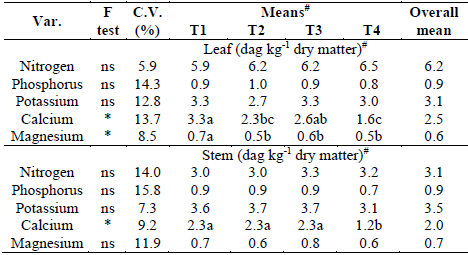
*significant at 0.05 probability level, ns not significant at 0.05 probability level, T1 - Nutrient solution (NS) of Furlani [6] 100%, prepared in municipal supply water (control), T2, T3 and T4 - respectively, NS of Furlani, 100, 75 and 50% prepared in treated domestic effluent),C.V. - coefficient of variation.
# Means followed by the same letter in the row do not differ by Tukey test at 0.05 probability level.
Source: The Authors
In treatment T4 (NS with 50% concentration of nutrients prepared in treated domestic effluent) the content of calcium in the leaves (Table 5) of ornamental sunflower plants decreased by 50.3% compared to the plants under treatment T1 (control - NS with 100% concentration of nutrients in supply water). Plants in the treatment T3 (NS with 75% concentration of nutrients in treated domestic effluent) did not differ statistically (p>0.05) from those of T1 and T2 (100% of NS in treated domestic effluent), and the latter did not differ from T4. For the magnesium content in the leaves, the treatment T1 differed from all other treatments and its mean content was 27.48% higher than that of the other treatments (Table 5).
For the content of Ca in stem tissues, in plants under T4 treatment (NS with 50% concentration of nutrients in treated domestic effluent), the content was significantly lower (45.73%) in comparison to the mean content of other treatments (T1, T2 and T3), which did not differ statistically (p>0.05) from one another. Despite these variations, plants did not show any symptoms of deficiency or toxicity neither in leaves nor in inflorescence.
The mean contents of nutrients found in the ornamental sunflower cv. Anão de Jardim varied in the following sequence: N>K>Ca>P>Mg in the leaf and K>N>Ca>P>Mg in the stem. This sequence is similar to that observed by Zobiole et al. (2010) in a study on rate of macronutrient absorption in sunflower crop in conventional cultivation system, except for the magnesium content, which was higher than the phosphorus content [3].
From the nutritional point of view, all treatments met the plants’ requirements, since there were no symptoms of nutrient deficiency and the contents of macronutrients, except for calcium and magnesium in the leaf and calcium in the stem did not differ among treatments. In addition, the capitula harvested in all treatments met the standards of commercialization established by Veiling® Holambra (2018) and [17] in terms of stem height, stem diameter and internal/external diameters of the capitula.
A comparative study arranging the results obtained for all 38 variables evaluated under different treatments, in relation to T1 (control), into four classes (with variation of <±10%, >±10%<±15%, >±15%<±20% and >20%) revealed that between the treatments T1 and T2 and between T1 and T3, 63% (24) of the variables showed results with maximum variation of <±10% and, on average, 12% (5 variables) of them showed results with variation of >±10% <±15% (Fig. 3A and B). The greatest differences in the variables (>±20%) in the treatments T2 and T3 relative to T1 were either due to the absolute and relative growth rates, which were compensated in a subsequent step of the evaluation, or due to the contents of nutrients, which despite the variations observed were found to be within adequate ranges, so these variations did not affect the quality of the capitulum produced and can be considered as not compromising.
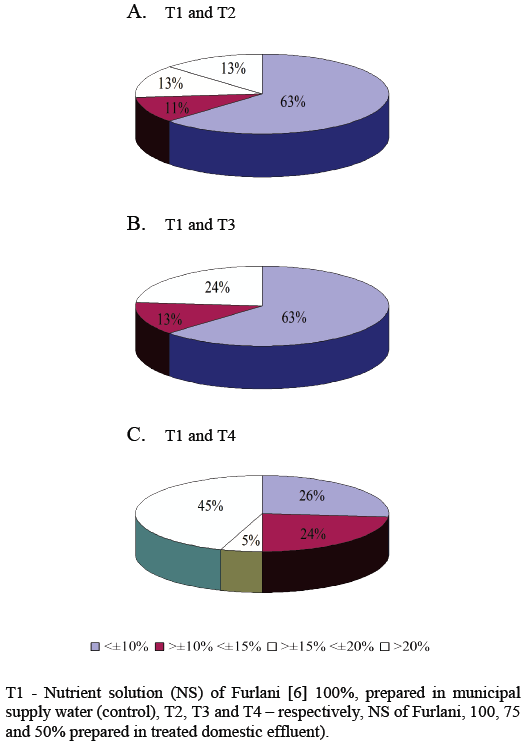
Source: The Authors
Figure 3 Comparison of results (percentage variation) for the 38 variables of ornamental sunflower cv. Anão de Jardim cultivated under different treatments.
On the other hand, in a comparison between results of the T1 and T4 treatments, only 26% (10) of the variables evaluated showed results with variation of <±10% and in this case the highest percentage of variables (45% or 17 variables) were grouped in the class with variation of >±20% (Fig. 3C). These results indicate that the plants in the treatment T4, even with acceptable characteristics for commercialization of stems, showed for most variables different results in comparison to those observed in the control treatment (T1), in contrast to plants of the treatments T2 and T3. These results allow us to infer that the use of treatment T4 (NS with 50% concentration of nutrients prepared in treated domestic effluent) should not be recommended for the cultivation of ornamental sunflower cv. Anão de Jardim.
5. Conclusions
The nutrient solution of Furlani for the production of the ornamental sunflower in hydroponic system can be prepared in treated domestic effluent,
At the initial growth stage, until 20 days after transplanting, there was no significant effect of the studied treatments on the biometric variables and dry matter accumulation in leaves, stem and shoots of ornamental sunflower plants,
Considering the standards for commercialization (stem height, stem diameter and capitulum diameter) and saving of fertilizers, the treatment T3 (nutrient solution with 75% concentration prepared in treated domestic effluent) is recommended for ornamental sunflower cultivation in hydroponic system with wastewater.
















